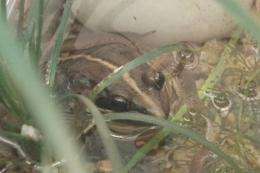Medical dye is good news for frogs

A readily available medical dye could become an key tool in amphibian conservation and management and the research is soon to be published in the Herpetological Journal.
Lead author and PhD candidate Leigh Martin said there was a real need to develop more humane marking methods for short –term studies especially for small species like the striped marsh frog (Lymnodynastes peronii). Leigh and fellow researchers work in the UTS Plant Functional Biology and Climate Change Cluster (C3) Biodiversity Research Group
"Invasive methods like toe-clipping, tagging , tattooing and branding can cause injury, increase the risk of infection and even alter the behaviour being studied. As part of my PhD research I need to trap and count small frogs and lizards over days rather than months and I need to be able to identify individuals so as not to double count."
"We focused on the striped marsh frog as a model species. It has many traits in common with other Australian frog species and is small, about the length of an average USB stick, so traditional marking methods aren’t generally appropriate," Leigh said.
The study showed that the common medical dye gentian violet was retained by the frogs for between 2 and 4 days and that the frogs remained healthy with no signs of pain or irritation. Mercurochrome and fluorescent powder were also trialled but were less successful.
Co-author and supervisor of Leigh’s PhD project, Dr. Brad Murray, said that this relatively simple and straightforward study has “broader implications for conservation and management and touches on animal ethics.
"Leigh and I are very concerned with the health and well-being of any animals we study so it’s great to be involved in work such as this where the results point to a simple, inexpensive and effective way to overcome the disadvantages of current methods."
Leigh was recently awarded the Society for Conservation Biology Prize for Best Spoken Paper on Conservation at the Ecological Society of Australia Annual Conference (2011) for his PhD research into the impact of invasive plant species on reptile communities.
More information: A comparison of short-term marking methods for small frogs using a model species, the striped marsh frog (Limnodynastes peronii) Leigh J. Martin and Brad R. Murray Herpetological Journal 21: 271 – 273, 2011.
Provided by University of Technology, Sydney



















